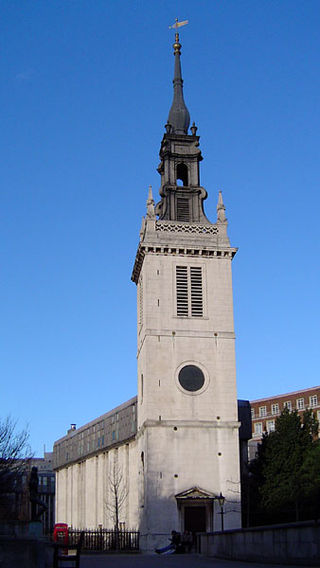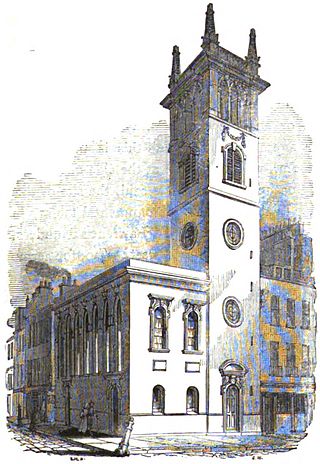
St Augustine, Watling Street, was an Anglican church which stood just to the east of St Paul's Cathedral in the City of London. First recorded in the 12th century, it was destroyed by the Great Fire of London in 1666 and rebuilt to the designs of Christopher Wren. This building was destroyed by bombing during the Second World War, and its remains now form part of St Paul's Cathedral Choir School.

St Mary Aldermary is an Anglican church located on Bow Lane at the junction with Watling Street, in the City of London within the United Kingdom.
St Margaret Lothbury is a Church of England parish church on Lothbury in the City of London; it spans the boundary between Coleman Street Ward and Broad Street Ward. Recorded since the 12th century, the church was destroyed in the Great Fire of London in 1666 and rebuilt by the office of Sir Christopher Wren. St Margaret Lothbury still serves as a parish church, as well as being the official church of five Livery Companies, two Ward Clubs and two Professional Institutes. It also has connections with many local finance houses, all of which hold special services each year.

All Hallows Bread Street was a parish church in the Bread Street ward of the City of London, England. It stood on the east side of Bread Street, on the corner with Watling Street. First mentioned in the 13th century, the church was destroyed in the Great Fire of London in 1666. The church was rebuilt by the office of Sir Christopher Wren and demolished in 1876.

All-Hallows-the-Great was a church in the City of London, located on what is now Upper Thames Street, first mentioned in 1235. Destroyed in the Great Fire of London of 1666, the church was rebuilt by the office of Sir Christopher Wren. All-Hallows-the-Great was demolished in 1894 when many bodies were disinterred from the churchyard and reburied at Brookwood Cemetery.

St George Botolph Lane was a church off Eastcheap, in the ward of Billingsgate in the City of London. The rear of the church overlooked Pudding Lane, where the fire of London started. It was first recorded in the twelfth century, and destroyed in the Great Fire of 1666. It was one of the 51 churches rebuilt by the office of Sir Christopher Wren. The church was demolished in 1904.

St Edmund, King and Martyr, is an Anglican church in Lombard Street, in the City of London, dedicated to St Edmund the Martyr. From 2001 it housed the London Centre for Spirituality, renamed the London Centre for Spiritual Direction, but is still a consecrated church. Since 2019, Imprint Church organises regular worship inside of the building.

St Benet Gracechurch, so called because a haymarket existed nearby (Cobb), was a parish church in the City of London. First recorded in the 11th century, it was destroyed in the Great Fire of London of 1666 and rebuilt by the office of Sir Christopher Wren. The church was demolished in 1868.

St. Matthew Friday Street was a church in the City of London located on Friday Street, off Cheapside. Recorded since the 13th century, the church was destroyed in the Great Fire of 1666, then rebuilt by the office of Sir Christopher Wren. The rebuilt church was demolished in 1885.

St Antholin, Budge Row, or St Antholin, Watling Street, was a church in the City of London. Of medieval origin, it was rebuilt to the designs of Sir Christopher Wren, following its destruction in the Great Fire of London in 1666. The 17th-century building was demolished in 1874.

The church of St Mildred, Bread Street, stood on the east side of Bread Street in the Bread Street Ward of the City of London. It was dedicated to the 7th century Saint Mildred the Virgin, daughter of Merewald, sub-king of the West Mercians. Of medieval origin, the church was rebuilt to the designs of Sir Christopher Wren following its destruction in the Great Fire of London in 1666. One of the few City churches to retain Wren's original fittings into the 20th century, St Mildred's was destroyed by bombs in 1941.

St Christopher le Stocks was a parish church on the north side of Threadneedle Street in the Broad Street Ward of the City of London. Of Medieval origin, it was rebuilt following the Great Fire of London in 1666, but demolished in 1781 to make way for an extension of the neighbouring Bank of England.

All Hallows Lombard Street, also seen with the descriptor Gracechurch Street, was a parish church in the City of London. It stood behind thin buildings fronting both streets in Langbourn Ward, The west and south sides faced into Ball Alley. Of medieval origin, it was rebuilt after the Great Fire of London. It was demolished in 1937; its tower was reconstructed at Twickenham as part of the new church of All Hallows, which also received its bells and complete interior fittings.

St Michael, Crooked Lane, was an ancient parish church situated on the east side of Miles's Lane in Candlewick ward in the City of London. It was rebuilt after the Great Fire of London by Sir Christopher Wren, and demolished in 1831.

St Dionis Backchurch was a parish church in the Langbourn ward of the City of London. Of medieval origin, it was rebuilt after the Great Fire of London to the designs of Christopher Wren and demolished in 1878.

All-Hallows-the-Less was a church in the City of London. Of medieval origin, it was destroyed in the Great Fire of London in 1666 and not rebuilt.

St Nicholas Olave was a church in the City of London, on the west side of Bread Street Hill in Queenhithe Ward. It was destroyed in the Great Fire of London and was never rebuilt. Instead the parish was united with that of St Nicholas Cole Abbey.

St Pancras, Soper Lane, was a parish church in the City of London, in England. Of medieval origin, it was destroyed in the Great Fire of London in 1666 and not rebuilt.

St Mary Woolchurch Haw was a parish church in the City of London, destroyed in the Great Fire of London of 1666 and not rebuilt. It came within the ward of Walbrook.

St. Leonard, Eastcheap, sometimes referred to as St Leonard Milkchurch, was a parish church in the City of London. Of medieval origin, it was destroyed in the Great Fire of London in 1666 and not rebuilt. The site of the church was retained as a graveyard.





















